JellyFish
Retrievable Choke Stone Anchoring Tool
Introduction
There have been occasions where I have been at a rappel looking for
an anchor and saw the perfect crack for a choke stone but...........
there were no rocks to be found. In 2013 I had the idea for the
JellyFish to solve this problem. After getting the details
worked out, Matt sewed one up for me.
Over the last few years we have used it in canyons here and there and
found it to be just one more useful tool in the proverbial tool box.
There are very few times when there is a dire need for such an anchor, but
when there is, the JellyFish fills the need well.
Originally, I wanted to make the
JellyFish and put it up for sale on the BG Gear web store. The
JellyFish fills a niche void in a niche sport and requires expert
judgment to use safely. Here it is 2019 and ultimately I
decided to simply throw the idea out to the canyoneering community. This page is simply
a base introduction to the making, use, and nuances' of the JellyFish
and is not intended to be polished or fully thought out. Each
person can decide if they want to make and use a JellyFish at their
own risk. If you do use the JellyFish, I would love to hear
about it.
Check out the page on how to
make a JellyFish if you want to make one and try it out.
Here is a video showing the major points on using the JellyFish.
For step by step pictures scroll down this page to the section on
how to use the JellyFish.
Basic Idea
The basic idea is to use a rope and wind it in a ball on PVC pipe (I
will call this retrieval rope). Place the body of the JellyFish
over the ball of rope (retrieval rope). Place the JellyFish
and rope ball in a crack and extend the tentacles through the crack.
Attach the rappel rope to the tentacles. Everyone rappels
using
the rappel rope which is anchored by the JellyFish wedged in the
crack. After everyone is down and
free of the rappel rope, the end of the anchor / pull rope is
pulled. As the retrieval rope is pulled, the ball
unwinds itself from the inside out allowing the ball to collapse as
more and more rope is pulled out. The end of the retrieval rope is also
attached to the Jelly Fish so that when the ball is fully collapsed
the rope pulls the JellyFish through the crack and everything comes
down to the bottom of the rappel.
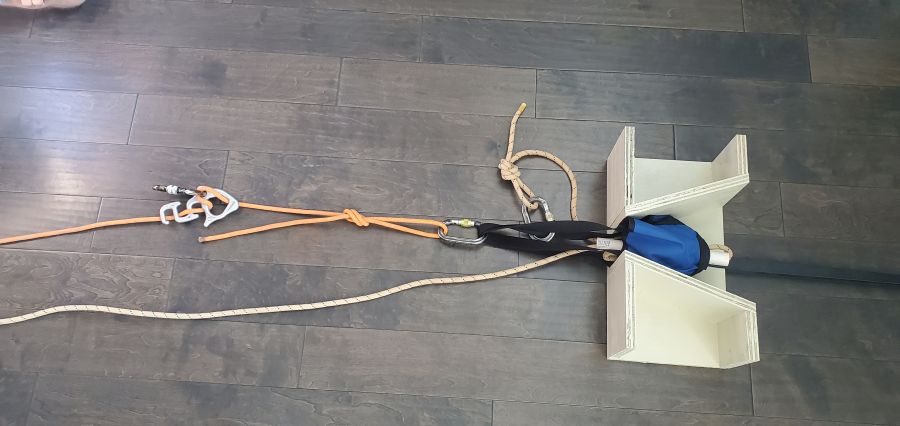 I might
later add some images here of the JellyFish used in a canyon setting.
For now this gives an overview of what the JellyFish is. The
plywood fixture on the right represents a flaring crack in a canyon
where you might use a JellyFish. A rope is wound into a ball
(light colored rope) and placed into the body of the JellyFish (the blue
fabric shown in the crack. A rappel rope (orange rope) is anchored
to the tentacles of the JellyFish (the black straps). After
everyone is down the retrieval rope (light colored rope) is pulled which
unravels the ball then pulls the JellyFish down with it to get the
entire system back.
I might
later add some images here of the JellyFish used in a canyon setting.
For now this gives an overview of what the JellyFish is. The
plywood fixture on the right represents a flaring crack in a canyon
where you might use a JellyFish. A rope is wound into a ball
(light colored rope) and placed into the body of the JellyFish (the blue
fabric shown in the crack. A rappel rope (orange rope) is anchored
to the tentacles of the JellyFish (the black straps). After
everyone is down the retrieval rope (light colored rope) is pulled which
unravels the ball then pulls the JellyFish down with it to get the
entire system back.
Why a PVC pipe you ask? The PVC pipe has two functions. The first
and least important function is to allow the ball of rope to be
wound on something. I say this is least important because arguably
you can wind the rope on itself. The second function is to allow a
bight of rope to pull through the ball, even when the ball is
tightly compressed into a crack. Rather the PVC pipe or just
the rope
itself is used to wind the ball on, a bight of rope still needs to be pulled through the
ball to begin the release. When a rope is folded in half, the rope
lays nicely side by side. The very end of the bight however can not
make the required sharp bend so it is wider than the two rope halves
laying side by side. If the ball of rope gets compressed very
tightly into the crack, there may not be enough room or compression
to allow the bight to be pulled through and the anchor would be
stuck. The PVC pipe allows for this room.
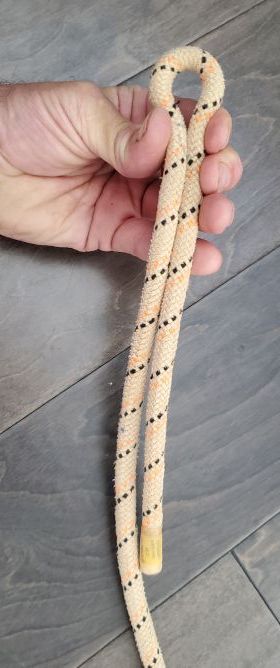 When a rope is
folded in half, the rope lays nicely side by side. The very end of the
bight however can not make the required sharp bend so it is wider than
the two ropes.
When a rope is
folded in half, the rope lays nicely side by side. The very end of the
bight however can not make the required sharp bend so it is wider than
the two ropes.
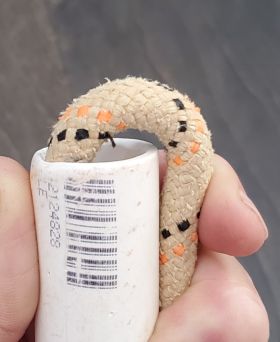 The extra room created by the PVC pipe creates extra room so that
the pipe-and-rope portion is the same width as the pipe-and-bight
portion.
The extra room created by the PVC pipe creates extra room so that
the pipe-and-rope portion is the same width as the pipe-and-bight
portion.
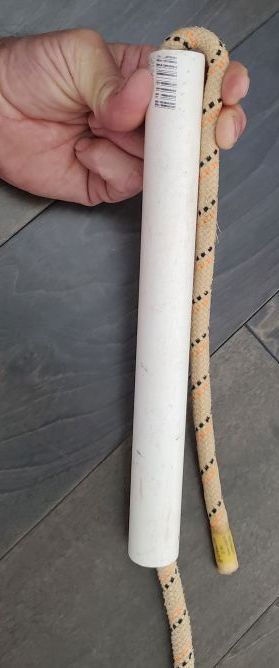 Now that the pipe and rope is the same width at all locations, the
pipe and rope can be pulled through a tight constriction with no wide
spots to deal with.
Now that the pipe and rope is the same width at all locations, the
pipe and rope can be pulled through a tight constriction with no wide
spots to deal with.
Expert Judgment / Considerations:
Rope management.
When first using the JellyFish, rope management
can get confusing but becomes easier with practice. Practice in a safe environment until you feel
comfortable with the entire process.
Rope compresses.
When the ball of rope is wound there is a lot of
open air space in the ball mixed in with the rope. Not only does
the rope itself compress but so does this extra air space. Keep
this in mind when setting up the anchor in a crack. As weight is
applied to the rappel rope the ball could compress to the point
where it slips through the crack and the anchor fails. The shape of
the crack and size of the rope ball are the big factors here.
If the rope ball is wound too small, it could compress enough to
slip through the crack. If the rope ball is wound too big it
may not fit the crack well and fail to wedge in tight and secure.
Not all cracks work.
Due to the compressibility of the ball
not all cracks are well suited for the JellyFish. This will be
a case by case evaluation that does require some real thought.
Some cracks will not flare down enough to allow for compression
while other cracks start so abruptly that there is no good place to
wedge the JellyFish where it will settle into a secure position. Slick,
smooth rock or mossy walls can make the JellyFish unable to properly wedge
between the crack walls. Be careful and use good judgment.
Backing up needs to be done right.
We have in the past clipped
a carabiner into the loop(s) near the back of the JellyFish to be
used as back up. I have since abandoned that practice as it
can easily disturb the JellyFish and unknowingly compromise the
anchor. As the JellyFish gets pulled into the crack and gests
squeezed in place it is important not to pull it up, back, sideways,
or any way that will dislodge it. If a safety line is attached
at the back it is too easy to accidentally dislodge the JellyFish
and be unaware it has become unsafe. The better back up option
is a separate rope tied to the rappel rope up by the tentacles.
This makes it less likely to accidentally dislodge the JellyFish, but
it is still possible. Pay attention.
Humans goof stuff up.
There are many issues that can be
caused from human error which adds to the need for expert judgment.
Winding the ball too loosely so it can compress too much.
Pulling on the anchor in an odd direction can dislodge the
JellyFish. For example when getting on rappel do not pull up
on the anchor, only exert force on the JellyFish in the direction it
will be loaded when in use. Do not step on the Jelly Fish when
moving into position for rappel. This sounds too obvious to
mention but I have seen it happen where people are unaware they
stepped on it. Since the JellyFish is used in cracks, it is
common to be in narrow spaces with restricted movement, so we all
step in odd places to get the job done. Try not to disturb the
JellyFish in any way after it is set and wedged in nicely.
Using the JellyFish
Now that the basic idea is out there, here are more details on how
we have used the JellyFish. Others may improve on
this basic starting point.
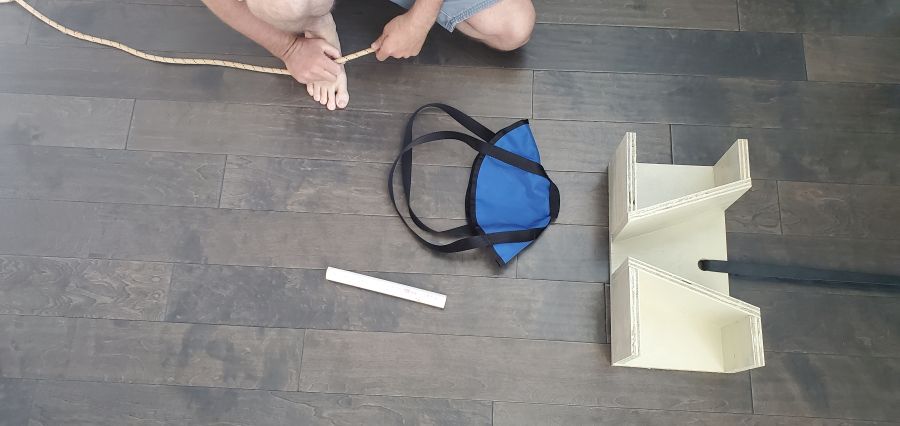 The
JellyFish anchor consists of the JellyFish itself (the blue fabric with
straps) and a PVC pipe (3/4 inch schedule 40) about 10 inches long.
The
JellyFish anchor consists of the JellyFish itself (the blue fabric with
straps) and a PVC pipe (3/4 inch schedule 40) about 10 inches long.
The plywood fixture on the right represents a flaring crack in a canyon
where a traditional chalk stone anchor can be used.
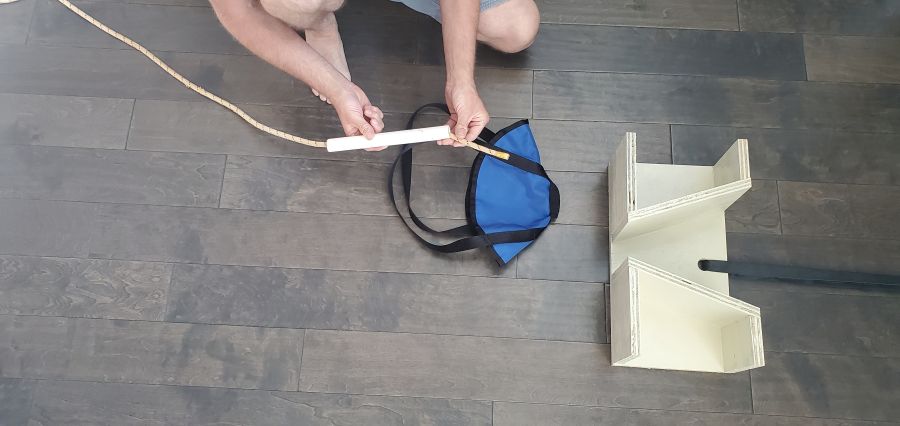 Pull the
end of the retrieval rope through the PVC pipe.
Pull the
end of the retrieval rope through the PVC pipe.
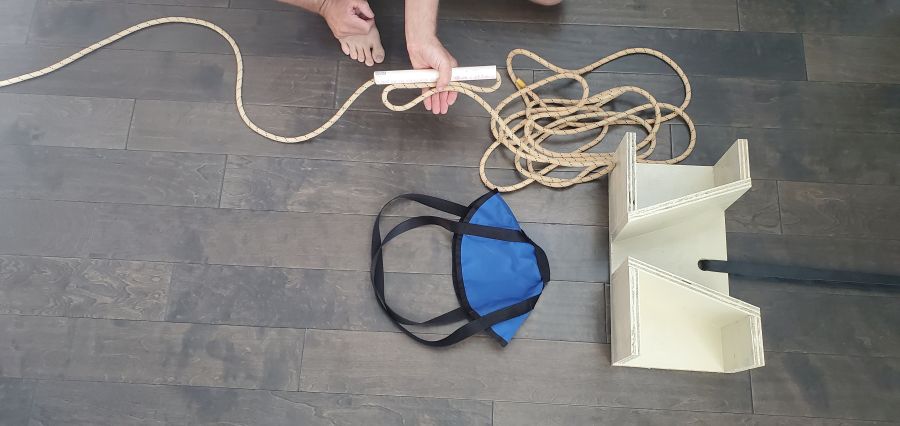 Pull enough
rope through the PVC pipe to allow a ball to be wound on the pipe.
The amount of rope pulled through will depend on how large you need /
want the ball to be. Every crack will be different and require a
different size ball to be wound. You will need to figure out how
much rope is needed on a case by case basis.
Pull enough
rope through the PVC pipe to allow a ball to be wound on the pipe.
The amount of rope pulled through will depend on how large you need /
want the ball to be. Every crack will be different and require a
different size ball to be wound. You will need to figure out how
much rope is needed on a case by case basis.
Next fold the rope
down over the pipe forming a bight at the end of the pipe then fold the
rope again forming a second bight alongside the pipe near the opposite
end. It is very important to keep the second bight shorter than
the pipe.
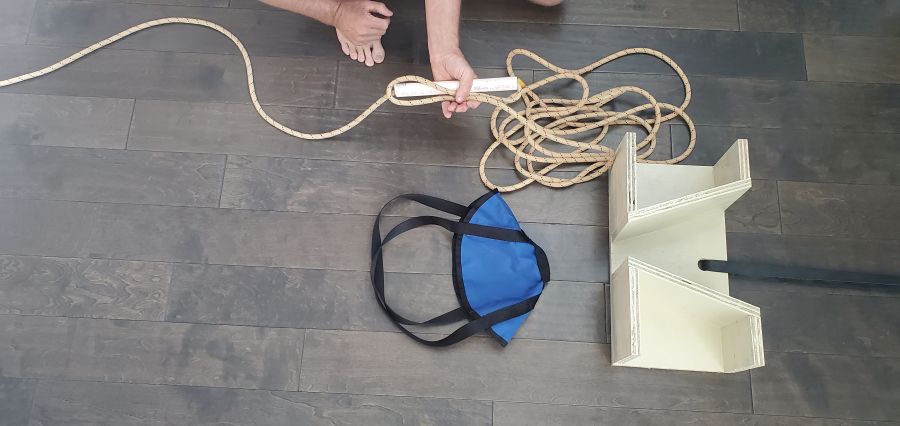 DO
NOT allow the second bight to be longer than the PVC pipe.
If the bight is too long the pipe can catch in the bight when the system
is pulled down and make it impossible to release the system.
Keeping the bight shorter than the pipe as shown in the previous image
helps ensure the pipe can be pulled out of the ball to retrieve the
system.
This can be adjusted after you have the rope ball formed in later steps
but it is very helpful to keep this in mind before winding the ball.
DO
NOT allow the second bight to be longer than the PVC pipe.
If the bight is too long the pipe can catch in the bight when the system
is pulled down and make it impossible to release the system.
Keeping the bight shorter than the pipe as shown in the previous image
helps ensure the pipe can be pulled out of the ball to retrieve the
system.
This can be adjusted after you have the rope ball formed in later steps
but it is very helpful to keep this in mind before winding the ball.
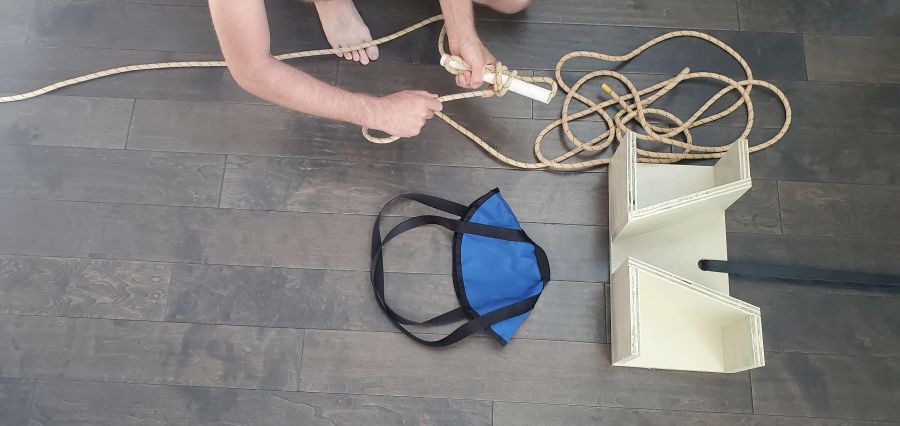 Begin
winding a ball around the center of the PVC pipe. While winding
the ball take note of large air gaps created and try to wind the rope
over top of those. This will help compress the voids a little and
make a finished ball that is a little more solid and less squishy.
Keep in mind that no matter how well the ball is wound it will still be
able to be compressed. When using the JellyFish keep this in mind
and evaluate the system to check if you feel safe using the JellyFish in
that particular crack.
Begin
winding a ball around the center of the PVC pipe. While winding
the ball take note of large air gaps created and try to wind the rope
over top of those. This will help compress the voids a little and
make a finished ball that is a little more solid and less squishy.
Keep in mind that no matter how well the ball is wound it will still be
able to be compressed. When using the JellyFish keep this in mind
and evaluate the system to check if you feel safe using the JellyFish in
that particular crack.
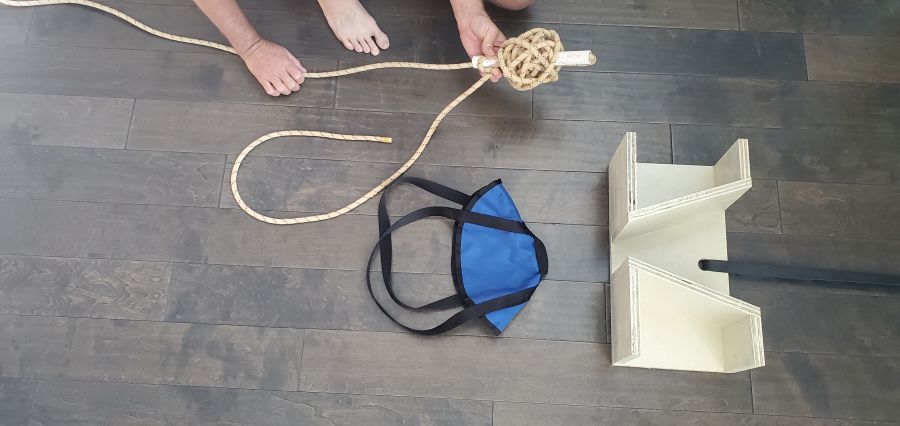 When the
ball is done you should have a short end of rope coming off of the
windings of the ball and the long rope coming out the end of the PVC
pipe. The long rope is the retrieval rope and needs to reach to
the bottom of the rappel. If the rope is not long enough you can
tie another rope to it.
When the
ball is done you should have a short end of rope coming off of the
windings of the ball and the long rope coming out the end of the PVC
pipe. The long rope is the retrieval rope and needs to reach to
the bottom of the rappel. If the rope is not long enough you can
tie another rope to it.
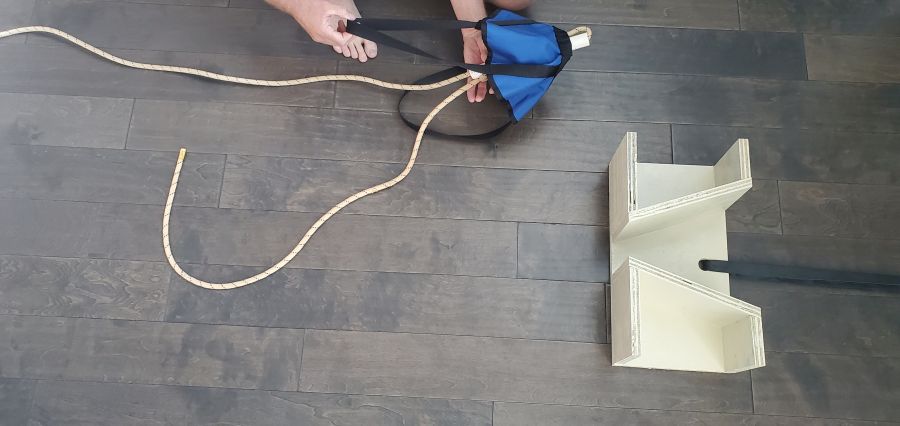 Place the
ball and pipe inside the JellyFish body with the end of the pipe and the
bight of rope sticking out the slit in the back of the JellyFish.
The slit offers a visual safety check when using the JellyFish. If
you can see the pipe and the rope sticking out of the slit, you know the
integrity of the rope ball has not been compromised.
Place the
ball and pipe inside the JellyFish body with the end of the pipe and the
bight of rope sticking out the slit in the back of the JellyFish.
The slit offers a visual safety check when using the JellyFish. If
you can see the pipe and the rope sticking out of the slit, you know the
integrity of the rope ball has not been compromised.
 There is a
lot going on here in this image. When you are set and ready to go,
the system should look something like this. A back up for the
system is not shown to keep the image clear. To get your system to
look like this do the following:
There is a
lot going on here in this image. When you are set and ready to go,
the system should look something like this. A back up for the
system is not shown to keep the image clear. To get your system to
look like this do the following:
Place JellyFish in the crack and
pull hard on both straps (tentacles) to fully wedge the JellyFish in the
crack.
Tie an overhand or figure 8 on a bight on the short
end of the retrieval rope. Clip the retrieval rope to one of the
straps (tentacles). This should be the short end of the rope that
is coming off of the windings of the ball. The long end of the
retrieval rope will be sent to the bottom of the rappel to pulled later.
Attach the rappel rope (orange rope) to BOTH
straps (tentacles) of the JellyFish and drop the other end of the rope
to the bottom of the rappel. It is VERY IMPORTANT to clip the
rappel rope to BOTH tentacles.
Adding a back up to the system
which is not shown.
To back the system up (and you do want to back it
up right?) you can tie another rope to the carabiner securing the rappel
rope or leave a very long tail on the knot in the rappel rope and use
that. It is NOT a good idea to attach a back up rope the the
JellyFish at the back near the slit. Any pull or movement of the
JellyFish should be avoided once it has been fully wedged into the
crack. Attaching a backup to the back of the JellyFish greatly
increases the risk that it can accidentally be moved and become
unstable.
Now everyone can rappel using the rappel rope (orange
rope). When getting on rappel it is important to pull on the
tentacles of the JellyFish ONLY in the direction it will be loaded when
on rappel. Do not stand up and pull upward or sideways or any
other way on the tentacles. It is very important to only pull in
the direction of the rappel.
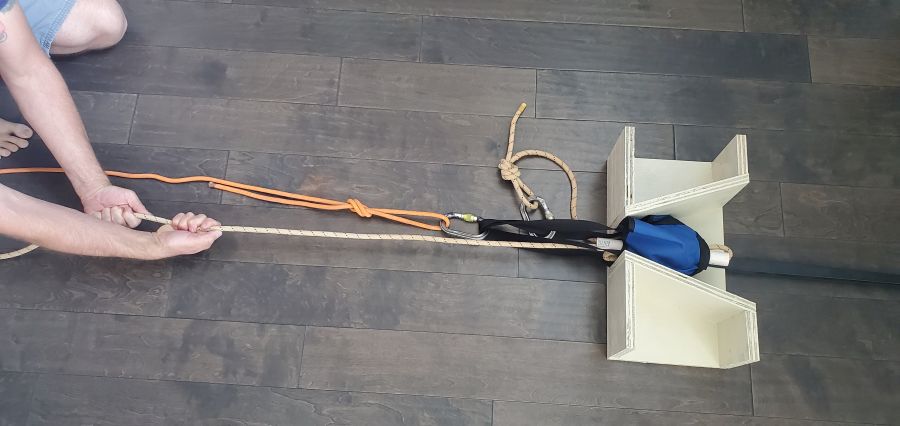 Once
everyone has rappelled and is at the bottom of the rap, the retrieval
rope is pulled to release and retrieve the system. Note that the
PVC Pipe is still sticking out the back slit of the JellyFish which is a
visual safety check each person can do before rappelling to know the
ball is still intact.
Once
everyone has rappelled and is at the bottom of the rap, the retrieval
rope is pulled to release and retrieve the system. Note that the
PVC Pipe is still sticking out the back slit of the JellyFish which is a
visual safety check each person can do before rappelling to know the
ball is still intact.
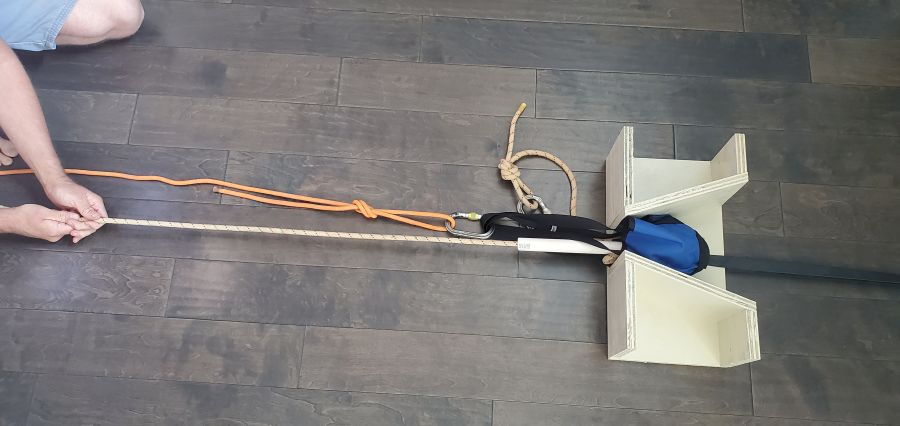 As the
retrieval rope is pulled the PVC pipe is pulled through the rope ball.
This is where the PVC pipe helps. If the rope ball was compressed
very tightly by the flaring crack, it would be hard to pull a bight of
rope through the constricted ball.
As the
retrieval rope is pulled the PVC pipe is pulled through the rope ball.
This is where the PVC pipe helps. If the rope ball was compressed
very tightly by the flaring crack, it would be hard to pull a bight of
rope through the constricted ball.
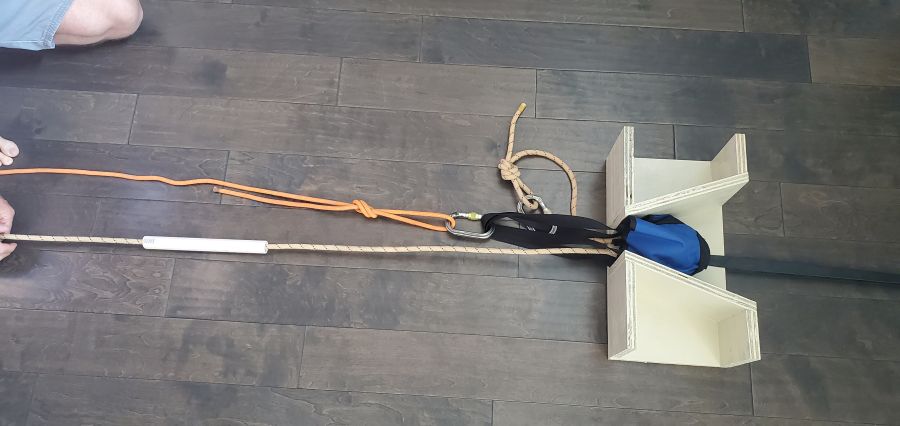 As the
retrieval rope continues to be pulled the pipe is comes free of the ball
and the rope begins to pull out of the center of the ball. The
ball continues to unwind itself from the center outward until there is
nor more rope left in the JellyFish.
As the
retrieval rope continues to be pulled the pipe is comes free of the ball
and the rope begins to pull out of the center of the ball. The
ball continues to unwind itself from the center outward until there is
nor more rope left in the JellyFish.
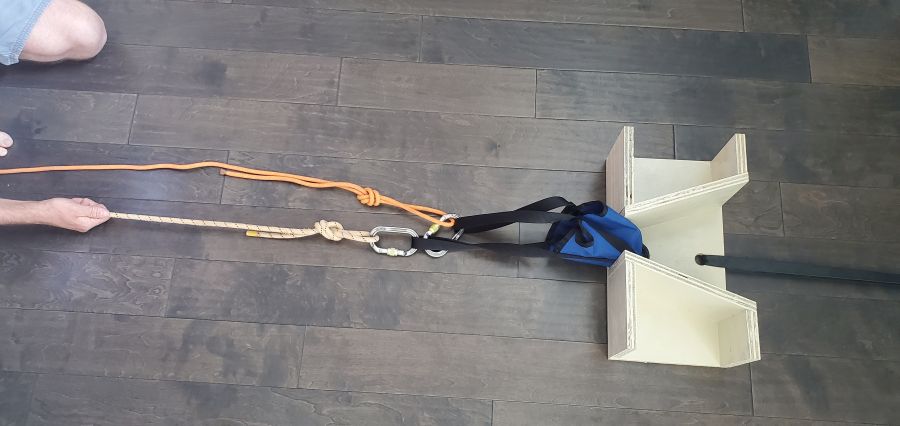 When all
the retrieval rope has pulled out of the JellyFish, the rope pulls on
the straps (tentacles) to pull the now collapsed JellyFish through the
crack.
When all
the retrieval rope has pulled out of the JellyFish, the rope pulls on
the straps (tentacles) to pull the now collapsed JellyFish through the
crack.
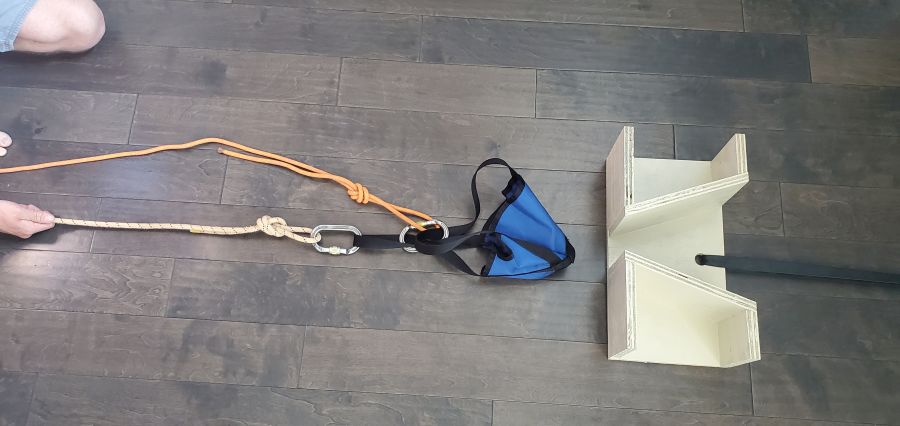 When the
JellyFish pulls out of the crack, the entire system is pulled down the
rappel to be cleaned up and taken with you.
When the
JellyFish pulls out of the crack, the entire system is pulled down the
rappel to be cleaned up and taken with you.